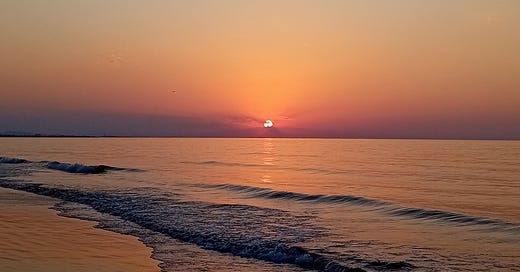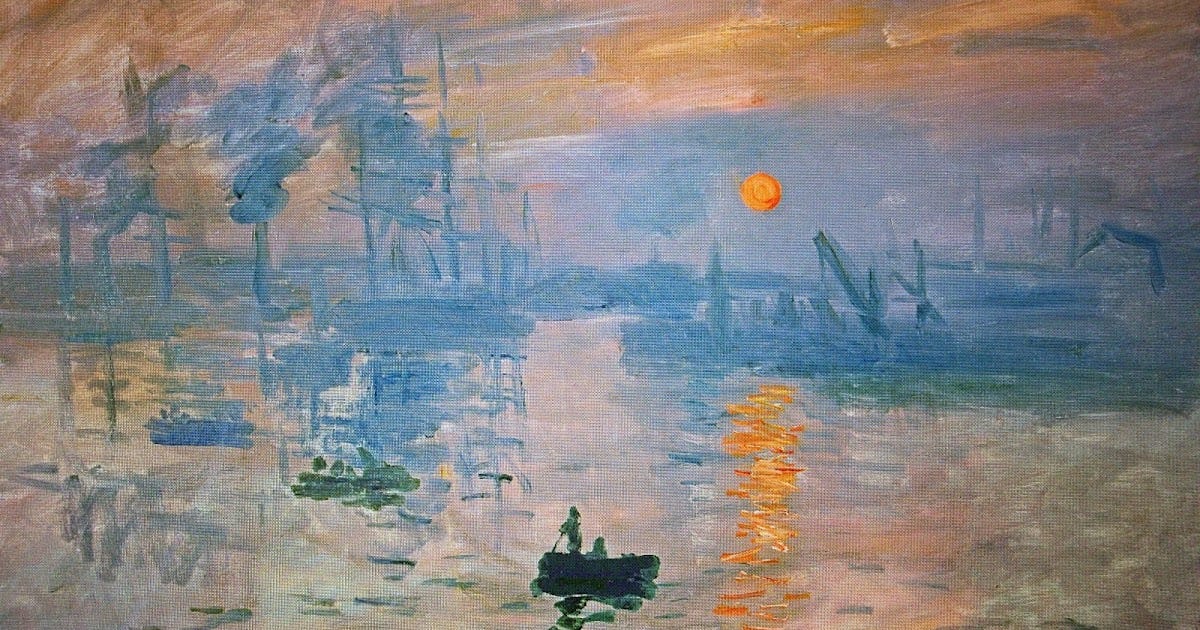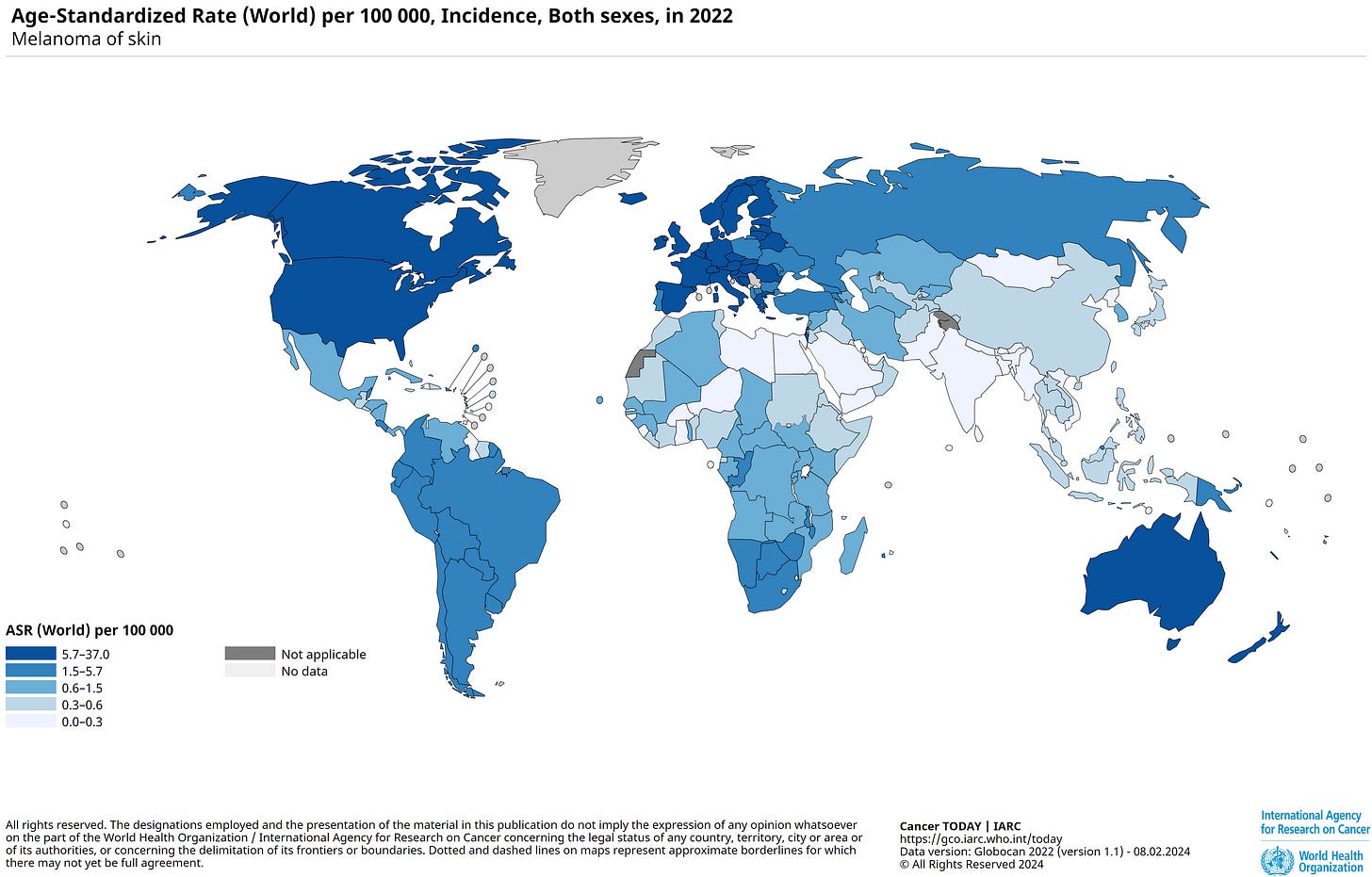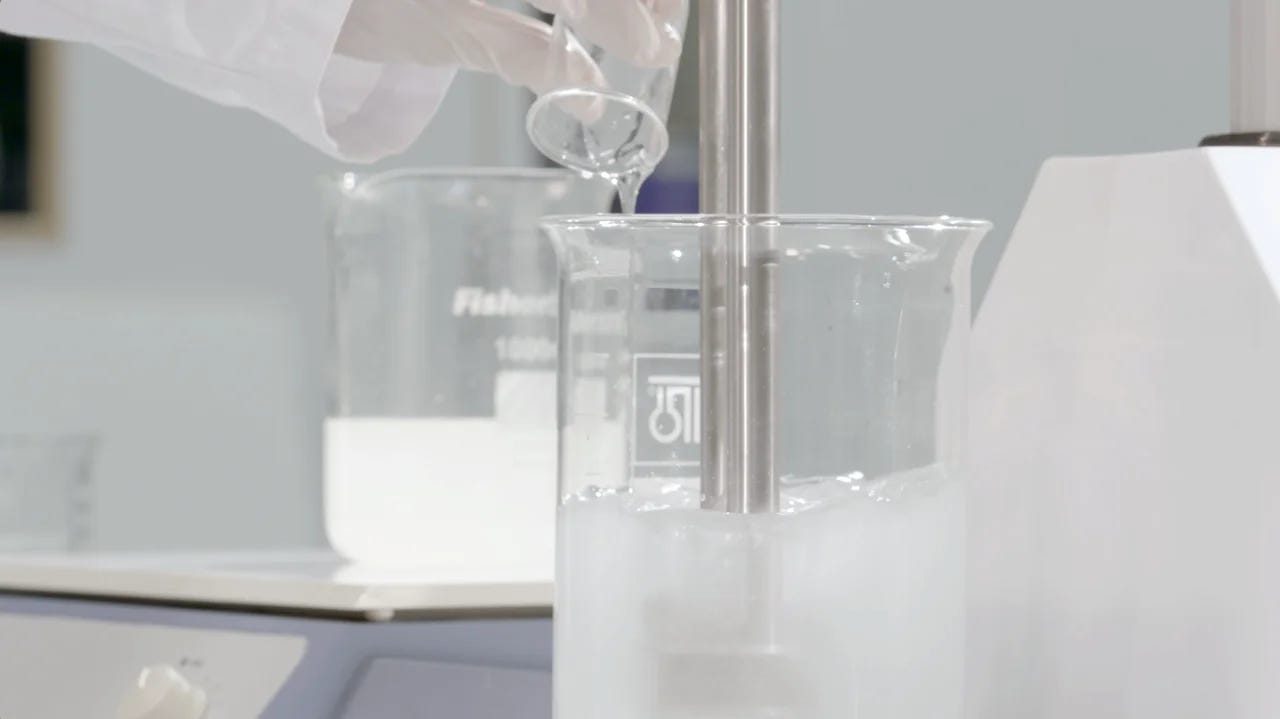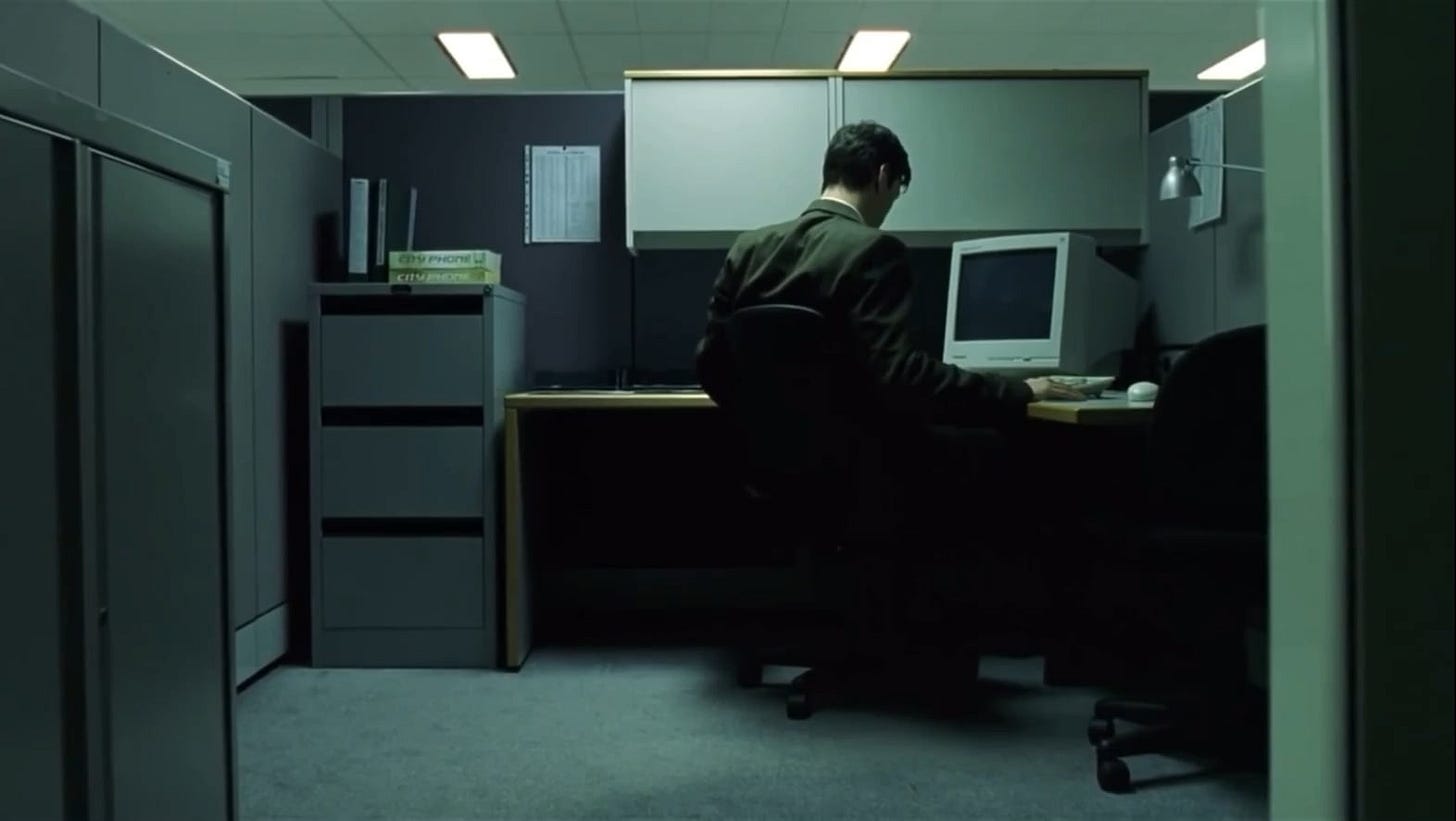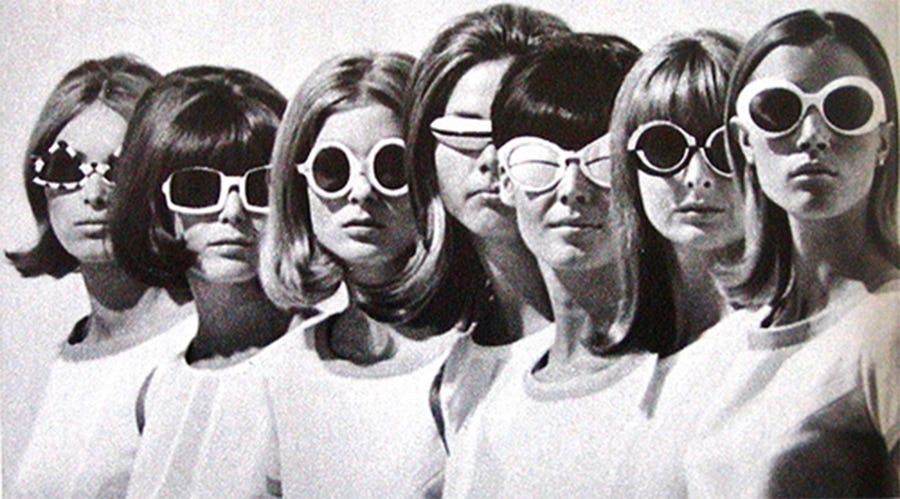Hello,
Welcome to another article from Serfdom Road.
The Sun
I have recently found myself asked often, on a hot, sunny day, “So, why don’t you wear sun cream?”
What will be explained in this article is not mainstream advice from the medical profession, yet, how can most information from the medical profession be trusted if the third-leading cause of death in the US is medical error?
Only five decades ago, doctors were still administering lobotomies (brain-hacking), not much further back, heroin and cocaine were prescription drugs - some modern pharma giants were the original suppliers.
More recently, in 2009, pharma giant Pfizer, was fined $2.3bn for fraudulent marketing - at the time this was the largest medical fraud settlement in history.
Why with our modern technology and medicine, are rates of disease still climbing?
Why are people more obese, sick, sad and helpless than previous generations?
Hopefully the rest of the article can be read with an open-mind…
Health is one of the most important factors to determine the freedom in your life.
The healthier you are, the more opportunities you will have in life.
Life’s challenges will not overwhelm you if you are in good health.
The fundamental contributors to good health are: food, water, air and shelter.
Without these, or if they are of low quality, death will find you soon enough.
One contributor, however, that is often ignored, that makes it all happen: the Sun.
The Sun is why we have the Earth.
The Sun is why we have plants and flowers.
The Sun is why we have warmth.
No Sun. No life.
Instinctively we know the Sun makes us feel better - otherwise why would millions of tourists from colder climates seek out the tropical Sun every year?
In ancient times, people were more connected to nature, and to the Sun, because most life existed outside - the Sun, the Moon and the stars allowed human beings to know the time of day and the month of the year.
Throughout history, the Sun has been worshipped in some form or another: the ancient Egyptians had their sun god Re; in Hinduism there is the sun god Surya; and the Japanese have the sun goddess Amaterasu (the Japanese flag is a solar symbol).
Even today, we worship the Sun while we wait in wonderment for the next solar eclipse.
The word eclipse is derived from the Greek word έκλειψη (eklipsis) which means: being abandoned.
The ancient Greeks viewed the loss of sunlight as a form of abandonment.
In ancient Chinese mythology, the solar eclipse was thought to be the result of a dragon eating the Sun.
Were the ancients just a backward group of sun-worshippers, or did they have an insight into the power of the Sun and the benefits of sunlight?
The Gregorian calendar used today in most countries is known as a solar calendar: one year is one revolution of the Earth around the Sun.
Why organise our lives around the path of a giant light in the sky, if it is does not have a crucial influence on us all?
There are numerous famous paintings with the Sun as a focus for the artist, across many genres of art, including Impression, Sunrise by Claude Monet (1872).
In more modern times, there are famous songs about the Sun, or refer to it metaphorically, including: House of the Rising Sun (The Animals, 1964); Summer in the City (Lovin’ Spoonful, 1966); Sunshine of Your Love (Cream, 1967); Here Comes the Sun (The Beatles, 1969); Seasons in the Sun (Terry Jacks, 1974); Walking on Sunshine (Katrina and The Waves, 1983); and Soak Up the Sun (Sheryl Crow, 2002).
It is not surprising the Sun appears throughout mythology, music and art, as it is integral to our own survival.
The Sun does not just maintain our world, it is also necessary for good health.
The main reason why we need the Sun is because it helps us produce the best source of vitamin D we need to survive.
Vitamin D3 (cholecalciferol) is produced from the absorption of sunlight, through our eyes and skin - some can be obtained through animal-based foods.
Vitamin D2 (ergocalciferol), however, it is less bioavailable and is only found in plant-based foods.
You can eat egg yolks, oily fish and plants but the Sun helps us to produce the best bioavailable source of vitamin D.
Without vitamin D, we would experience a loss of calcium which in extreme cases can lead to osteoporosis. Low vitamin D can also contribute to depression, cognitive impairment, schizophrenia and ADHD.
So how did the Sun become demonized as a cancer-causing light in the sky that will soon have you buried in a grave?
“Wait, let’s sit in the shade, don’t want to get cancer!”
“Put some sun cream on otherwise you’ll get skin cancer!”
Skin cancer, often said to be caused by excessive exposure to the Sun, is an abnormal growth of skin cells.
There are three major types: basal cell carcinoma, squamous cell carcinoma and melanoma.
“Basal cell carcinoma is a type of skin cancer. Basal cell carcinoma begins in the basal cells — a type of cell within the skin that produces new skin cells as old ones die off.”
“Squamous cell carcinoma of the skin is a type of cancer that starts as a growth of cells on the skin. It starts in cells called squamous cells. The squamous cells make up the middle and outer layers of the skin. Squamous cell carcinoma is a common type of skin cancer.”
“Melanoma is a kind of skin cancer that starts in the melanocytes. Melanocytes are cells that make the pigment that gives skin its color. The pigment is called melanin.”
The first glaring issue with attributing the Sun to skin cancer: it can “…also occur on areas of your skin not ordinarily exposed to sunlight.”
If so, how do scientists explain those cases of skin cancer?
A first place to start is where are the highest rates of skin cancer in the world?
What do you notice?
The highest incidence of melanoma of the skin are in the wealthiest countries: Europe, USA, Canada, Australia and New Zealand.
The highest incidence is not in the hottest countries, as you might expect.
The highest incidence is also not only in the countries with a colder climate, because Australia has one of the highest incidence of melanoma of the skin.
What type of life do most people lead in wealthy countries today?
A sedentary one…mostly indoors.
For much of the existence of human beings, our lives were spent outside and we did not have artificial lighting - only the Moon could extend our daily lives into the evening.
Until the invention of the lightbulb, in 1880, our daily life revolved around sunlight - we woke up to the sunrise and we fell asleep not long after sunset.
There was no sunscreen and people did not wear sunglasses.
Were people contracting and dying of skin cancer at the same rate as today?
Despite melanoma (a type of skin cancer) being discovered by René Laennec (b. 1781, d. 1826), in 1804, you can see from the chart above that mentions of melanoma in scientific journals only started to become prevalent in the 1970s.
So it is reasonable to infer that skin cancer is only a recent medical phenomenon.
It may be a surprise but there is one other disease caused by a deficiency of vitamin D: skin cancer.
Too much Sun and you get skin cancer; too little and you also get skin cancer…maybe that makes sense?
People in wealthy countries spend too much time indoors, causing low vitamin D, which also causes…melanoma of the skin.
Conversely, people in poorer countries spend more time outside because they have to labour outside to be able to maintain their standard of living.
Exposure to sunlight is important in order to produce adequate levels of vitamin D.
Sunlight consists of two different types of UV radiation: UVA and UVB.
UVA radiation has a longer wavelength that can penetrate deeper into the skin, whereas UVB has a shorter wavelength that causes most burning of the skin.
Although UVB is about 5% of the Sun’s radiation, it has much more energy than UVA radiation.
UVB radiation also promotes the development of vitamin D3.
So what else do people in wealthy countries do to block UV radiation?
They cover themselves in a chemical goo known as sunscreen.
Sunscreen
Firstly, any sunscreen that claims to have UVB protection is also preventing the production of vitamin D3 on the skin.
In case you are still unsure of the dangers of sunscreen, maybe you are not aware that, in 2021, pharma giant Johnson & Johnson recalled 5 brands of their sunscreen because it contained a carcinogen.
Benzene, while not an ingredient in sunscreen, was detected in the recalled products - the highly flammable gas is known to cause leukemia.
Now, before reviewing some of the major ingredients in sunscreen, think about this: do you think the sunscreen just absorbs into your skin and can be washed away?
No.
Anything that is absorbed into your skin ultimately finds a way to enter your bloodstream, and then into your organs.
Your liver and kidneys have to do work to remove toxins from your body.
Alumina
A key ingredient, in at least some sunscreens, is aluminium oxide.
Aluminium oxide, also known as Alumina, is a “…multi-functional helper ingredient that's used mainly as a pigment carrier. The pigment can be an inorganic sunscreen (such as titanium dioxide)…This special treatment enables pigments to be evenly dispersed in the formula and to be spread out easily and evenly upon application.”
Alumina is also used as an abrasive material (imagine that entering your bloodstream), it is also used in electrical insulation and other chemical processes.
A not well-known consequence of excess aluminium in the body, especially if it crosses the blood-brain barrier, is Alzheimer’s disease.
According the Canadian Center for Occupational Health and Safety, “Post-mortem examinations of humans with Alzheimer's disease sufferers show that many have higher amounts of aluminum than normal in their brains.”
However, they also claim that “…any association with aluminum is still unknown.”
What is more peculiar is that Alzhemers’s Research UK have an article on their website - “Aluminium and Alzheimer’s: An unproven link”.
How can post-mortem examinations of Alzheimer's disease sufferers, showing high amounts of aluminium in the brain, mean there is an unproven link?
There is one study conducted by Dr. Lucia Tomljenovic, of the University of British in Colombia, in 2011, that shows a clear link between aluminium and Alzheimer’s disease.
Aluminium is a known neurotoxin, without question, and any amount that enters your body is increasing the risk of further health problems later in life.
Aluminium is also a pro-oxidative, meaning it causes damage to the skin, and therefore can cause what?
Skin cancer.
Aluminium salts are also used as a carrier of the inorganic compound used to provide protection against UV radiation.
Titanium
Two other popular inorganic compounds are titanium and zinc oxide.
Exposure to titanium can lead to tightness and pain in the chest, coughing and difficulty breathing.
If you have ever used sunscreen that appears to be more viscous, difficult to disappear into the skin or leaves a whiteish tint on the skin, it is likely to contain titanium.
To solve this problem “…the best solution so far is using nanoparticles.”
However, “…nanoparticles…are so tiny that they are absorbed into the skin more than we want them. Once absorbed they might form unwanted complexes with proteins and they might promote the formation of evil free radicals.”
Free radicals are unstable atoms that can damage cells, causing ageing and illness.
Maybe you have heard that the Sun causes ageing? Well, maybe it is the sunscreen, not the Sun.
Also, when toxic inorganic compounds are absorbed into the skin (not just from sunscreen), the liver and kidneys have to remove these from the body. One of the pathways of removing toxins is to release them back to the skin. These areas of accumulated toxicity lead to…skin cancer.
This is why we get acne, and why yellow skin is a sign of liver disease.
Nivea Sun, a popular sunscreen brand, contains titanium dioxide and even includes “(nano)” in the ingredients list.
Oxybenzone
Another chemical agent used for UV protection is Oxybenzone.
However, it is “…somewhat controversial. First, its molecules are small…and very lipophilic (oil loving) and these properties result in very good absorption…it absorbs so well that 4 hours after application of a sunscreen product with BP-3, it can be detected in urine.”
If that wasn’t enough, “…BP-3 is nowadays the most common allergen found in sunscreens, and [benzophenones] have been shown in some studies to promote the generation of potentially harmful free radicals".
If this ingredient can be detected in urine then you can be sure that every other ingredient has been absorbed into your body.
Avobenzone
Another ingredient often found in sunscreen, Butyl Methoxydibenzoylmethane or Avobenzone “…is the only globally available chemical sunscreen agent that provides proper UVA protection…It is the global gold standard of UVA protection and is the most used UVA sunscreen in the world.
It gives very good protection across the whole UVA range…The problem with it, though, is that it is not photostable and degrades in the sunlight…avobenzone loses 36% of its UV-absorption capacity after just one hour of sunlight…”
“Interestingly, the combination of avobenzone with mineral sunscreens (that is titanium dioxide and zinc oxide) is not a good idea. In the US, it is flat out prohibited as avobenzone becomes unstable when combined with mineral sunscreens.”
When any chemical degrades on the skin, it can be safe to assume that this will lead to further cell damage.
So how is UV radiation supposed to be causing cell damage but applying a toxic goo that also causes cell damage is a good idea?
Octinoxate
One other similar ingredient is Ethylhexyl Methoxycinnamate or Octinoxate is a “…clear, oil-soluble, "cosmetically-elegant" liquid that is the most commonly used chemical sunscreen. It absorbs UVB radiation…It only protects against UVB and not UVA rays…It is not very stable either, when exposed to sunlight, it kind of breaks down and loses its effectiveness…”
Just one more ingredient that degrades on the skin, and is clearly being absorbed into the skin if it needs to be reapplied after a few hours.
Vegetable and Seed Oils
Many sunscreens also contain vegetable or seed oils and Nivea Sun contains hydrogenated rapeseed oil.
It is becoming more clear now that vegetable and seed oils are a cause of most types of cancer and heart disease.
It is not surprising when some vegetable or seed oils are manufactured using other chemicals, if mechanical extraction is not used.
In using solvent extraction, an oil-derived liquid, hexane, is used in the process, while hydrogenated oils are manufactured with a metal catalyst.
This oil is likely being absorbed into your skin, and therefore into your bloodstream.
Conclusion
If you are by now at little nauseous at reading these long latin-sounding chemical names, hopefully this is to remind you that sunscreen is not a soothing cream with a relaxing scent of coconut but a chemical goo that is toxic to the body.
This is also a reminder that some of what is in your sunscreen, is also in your shampoo, shower gel, and even household cleaning products.
The ingredients reviewed above are just a small sample of all the chemicals in your favourite brand of sunscreen.
Each chemical added has a slightly different UV protection and photostable profile, and therefore a different effect on the body: from allergic reactions to possible Alzheimer’s disease.
There is another danger of sunscreen: it blocks the body’s natural response to produce melanin to protect the skin and allows you to stay in the Sun longer than you would naturally.
The SPF (solar protection factor) of a sunscreen is the theoretic amount of time longer you could stay out in the sun without burning - if it would take 10 minutes for you to burn without sunscreen then an SPF 15 sunscreen would enable you to stay in the sun for two-and-a-half hours.
That might sound good but the sunscreen is not blocking all UV radiation all the time, and meanwhile your body is not producing enough melanin - your body’s natural sun protection.
Sunscreen is just one component limiting our natural relationship with the Sun.
We now live in a mostly indoor environment that has most people worshipping a new type of light.
Artificial Light
Once the Sun sets over the horizon, the world is plunged into darkness, only to be illuminated by the Moon and the stars.
Since the dawn of man-made fire, the oil lamp (10,000 B.C.), the candle (3,000 B.C.), the light bulb (1802), incandescent light bulbs (1880) and now LEDs (21st century), humans have been trying to extend the amount of light available after sunset.
Commercially-available and mass-produced artificial lighting has only been available in the last 200 years of humanity’s 500,000 year existence.
Is this technology another great-leap-forward in our basic standard of living, or is there a cost?
Are we really meant to live under artificial lighting for hours a day, without any negative consequences?
Most of the following information is taken from the scientific paper, “Effects of light on human circadian rhythms, sleep and mood”.
Humans live in an environment, in which light follows darkness, each day.
Our circadian pacemaker, is entrained to the 24-hour solar day via a pathway from the retina (part of the eye) and synchronises our internal biological rhythms.
Rhythmic variations in outdoor light impact behaviours such as rest during sleep and activity during wakefulness as well as their underlying biological processes.
Rather recently, the availability of artificial light has substantially changed the light environment, especially during evening and night hours.
This may increase the risk of developing circadian rhythm sleep–wake disorders (CRSWD), which are often caused by a misalignment of internal circadian rhythms and external light–dark cycles.
There are now numerous sources of artificial light: indoor lighting, streetlamps, vehicles, traffic lights, TV, computers, tablets and smartphones.
The most important signal the brain receives is ambient light in the environment.
To understand the effects of light on the human physiology, it is important to understand light.
During the day, light intensities outside can reach illuminances up to 100,000 lx in direct sunlight and 25,000 lx in full daylight (a candle is around 10 lx). Light intensities in closed rooms are considerably lower and standard office lighting is only ~500 lx, often lower.
The spectrum of daylight, which is light from the sun filtered by the atmosphere is relatively broadband in its distribution.
The availability of daylight depends on geographical location and season. In the timeframe of human evolution, it is a rather recent development that light can be available during all times of day through artificial light.
Although daylight and artificial “white” light may appear similar to the retina, they provide a different spectrum of light, and therefore a different affect on the circadian rhythm.
From the image above, you can see that daylight provides a broad spectrum of wavelengths of light, that change throughout the day.
At midday, we are exposed to mostly blue light, which energises our mind and body.
At night, we are exposed to more red light, which can allow us to fall to sleep.
Most gadgets today emit blue light (see Cool White LED chart), which when used at night can disturb our sleep.
As far as the impact of light on the circadian system is concerned, the light received by the eyes is transmitted through the optic nerve and reaches the pineal gland, which is connected to the hypothalamus. The synchronization of circadian rhythms is related to the hormonal system, and the result is perceived by the alertness fatigue, and emotional levels (Seasonal Affective Disorder, SAD).
This is why we feel good in the Sun: sunlight reaches our eyes and causes a release of beneficial hormones that improve our mood.
Lighting our environment artificially long into the night, also suppresses the production of melatonin - the hormone that regulates sleep.
This is also partly why there are sleep disorders: people are spending too much time at night indoors under artificial lighting.
What is another benefit of melatonin? It prevents…cancer.
If you want your circadian rhythm to work properly; get out of bed early with bundles of energy, and sleep soundly at night, then the best light source is natural light, and you need to be exposed to this light throughout the day.
However, it is not just the sunscreen and artificial light that inhibits the production of vitamin D3 or affects our mood, sunglasses also do as well.
Sunglasses
“When you get up in the morning and the light is hurt your head
The first thing you do when you get up out of bed
Is hit that streets a-runnin' and try to beat the masses
And go get yourself some cheap sunglasses” ZZ Top, Cheap Sunglasses (1979)
The first mass-produced sunglasses did not appear until 1929, produced by Sam Foster, founder of Foster Grant, who was inspired by the Hollywood stars of the day that wore sunglasses to protect their eyes from movie studio lighting.
It was not until the 1960s and 1970s, that sunglasses became more popular, through popular advertising campaigns.
How were human beings able to go without sunglasses for millennia and now need advertising campaigns filled with Hollywood stars to nudge them towards owning sunglasses too?
Sunglasses are supposed to block UV radiation from your eyes and enable you to see without discomfort while exposed to strong sunlight.
However, here is the first problem: your eyes are not downloading signals from the ever-changing wavelength and intensity of sunlight, in order to regulate your hormones, body temperature and other biological processes.
Sunglasses, just as artificial light, disturb your circadian rhythm.
Sunglasses also cause the pupil in our eyes to dilate, in order to receive more light, therefore endangering your eyes when you remove the sunglasses.
Sunglasses also reduce your ability to adapt to strong sources of light - you become light-sensitive.
Another danger of sunglasses is that your eyes are not receiving a signal to produce more melanin to protect you from stronger sunlight.
In 2001, there was study done in Japan that “…found that mice that had only their eyes exposed to ultraviolet light got a full body tan.”
While this doesn’t explain how some parts of our body do not tan when not exposed to sunlight, it does show a link between sunlight contacting your eyes and melanin production in the skin.
“Oh but my eye doctor says I should wear them to avoid cataracts!”.
Human beings have been out in sunlight from sunrise to sunset for nearly all of our existence.
Where is the historic epidemic of cataracts, blindness and skin cancer?
Why, in recent times, is skin cancer now a problem, as well as sleep disorders?
Is it not due to the use of toxic sunscreen, artificial light exposure, use of sunglasses and living a mostly indoor lifestyle?
Fear the Dark, Not the Light
In the novel series, Lord of the Rings (first published in 1954), by J. R. R. Tolkein (b. 1892, d. 1973), there is a character called Gollum, who’s previous name was Sméagol, that spent most of his life in a deep cavern in the Misty Mountains, after being disowned by his family.
The character, after spending much of his life in complete darkness, undergoes a horrific transformation from a human being to “a small, slimy creature”.
His eyes are dilated due to the lack of sunlight, his teeth, hair, skin and bones are damaged from the obvious lack of vitamin D.
He is also paranoid, depressed and even schizophrenic.
While no human being can undergo this transformation in a lifetime, it is a literary example of the damage an inadequacy of natural sunlight can do to the human body and mind.
In a sense, most people may as well be in a deep cavern in the Misty Mountains.
You may be outside (well mostly indoors) but with all the avoidance of natural sunlight, you are on a path to being a Gollum-like character.
It is interesting that in the Lord of the Rings story, Gollum is obsessed with a golden ring that can provide immense power to him.
The golden ring itself can be a metaphor for the Sun and the immense power it’s energy and light provides for us.
Gollum’s own deteriorating mental health being another sign of a soul in desperate need of a brighter day.
In the novel Time Machine (1895), by H. G. Wells (b. 1866, d. 1946), a Victorian inventor creates a time machine and travels 100,000s years into the future.
In this dystopian world, there is a new species of human, called Morlocks, that live underground and rarely visit the surface.
They are believed to be descendants of the working-class that were forced to work underground and have since mutated into these ape-like creatures.
Sounds like a possible sequel to the German movie, Metropolis (1927), about a futuristic dystopian city powered by the labour of the literal under-class tirelessly working underground.
It may seem a far-fetched idea but what if this continued avoidance of sunlight, an indoor lifestyle and an adaptation to artificial light, over the next few centuries, will lead to a degenerated version of ourselves in the near future?
What if the propaganda used to make you scared of the Sun is how we become accustomed to working underground just like those in Metropolis and The Time Machine?
Computer games, Netflix, porn, sport…they all keep us entertained in our little cocoons. Happy. Excited. Ignorant. Numb.
Human beings have long evolved to live and thrive under the light and energy of the Sun.
The recent development of sunscreen, sunglasses and an indoor lifestyle have slowly separated human beings from their natural habitat.
The Sun helps us to regulate our hormones, temperature and sleep.
Any deviation from our natural existence is partly causing this recent rise in cancer, mental health disorders and sleep disorders.
It is time to embrace the power of the Sun once again.
Step Into The Light
If you accept for the moment that the Sun, to a certain degree, is still harmful to you, then you have to at least accept that clearly the Sun provides some benefit to you.
Without enough exposure to the Sun, you will not receive enough vitamin D3, and you will not have any of the hormonal benefits of sunlight either.
So, you need some Sun.
If, you are also layering up the sunscreen everyday and your only light source is the artificial light in your office, then you are increasing your risk of cancer and other health complications.
Like anything in life, too much can be a bad thing - too much water and we can drown but we don’t avoid water completely.
So why not just avoid the Sun when you do not want any more exposure?
It is best to just wear more suitable clothing if you cannot cope with any more sun exposure, not to cover yourself in a toxic goo.
You can also also try natural sunscreen like beef tallow, or other animal-based fats that contain minerals good for your skin.
However, you can also use your body’s natural response to sunlight: release melanin to produce a darkening of the skin.
You can build up your exposure to the Sun safely and patiently until you have a stronger natural protection - free of chemicals.
If your eyes are sensitive to the Sun, you can simply start by looking low to the ground and slowly moving your head upwards as you become adjusted to the stronger sunlight, or simply wear sunglasses sparingly.
It is no coincidence the increase in cancer, heart disease, mental and sleep disorders has happened at the same time our world has become disconnected from nature.
Saturating our bodies with toxins from chemical products will also increase the possibility of health problems later in life.
It is an uncomfortable truth that we can no longer live long into the night, only to be illuminated by artificial light, while avoiding the healing power of sunlight during the day, and expect to be healthy.
Live a life more connected to nature, and therefore a more optimal life for you…step into the sunlight…and smile.
“The Sun is a daily reminder that we, too, can rise again from the darkness, that we, too, can shine our own light.” Sara Ajna
I hope you have enjoyed reading this article.
Please feel free to comment below.
Kind regards,
Le Libérateur
Please subscribe for free and share!

